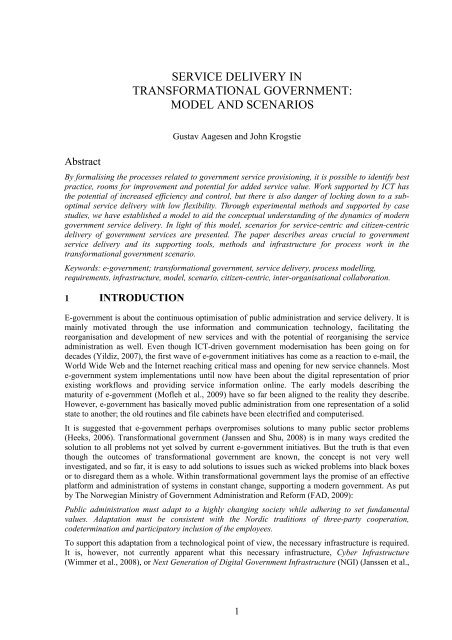Multi-channel provisioning of public services - Department of ...
Multi-channel provisioning of public services - Department of ...
Multi-channel provisioning of public services - Department of ...
You also want an ePaper? Increase the reach of your titles
YUMPU automatically turns print PDFs into web optimized ePapers that Google loves.
SERVICE DELIVERY IN<br />
TRANSFORMATIONAL GOVERNMENT:<br />
MODEL AND SCENARIOS<br />
Abstract<br />
Gustav Aagesen and John Krogstie<br />
By formalising the processes related to government service <strong>provisioning</strong>, it is possible to identify best<br />
practice, rooms for improvement and potential for added service value. Work supported by ICT has<br />
the potential <strong>of</strong> increased efficiency and control, but there is also danger <strong>of</strong> locking down to a suboptimal<br />
service delivery with low flexibility. Through experimental methods and supported by case<br />
studies, we have established a model to aid the conceptual understanding <strong>of</strong> the dynamics <strong>of</strong> modern<br />
government service delivery. In light <strong>of</strong> this model, scenarios for service-centric and citizen-centric<br />
delivery <strong>of</strong> government <strong>services</strong> are presented. The paper describes areas crucial to government<br />
service delivery and its supporting tools, methods and infrastructure for process work in the<br />
transformational government scenario.<br />
Keywords: e-government; transformational government, service delivery, process modelling,<br />
requirements, infrastructure, model, scenario, citizen-centric, inter-organisational collaboration.<br />
1 INTRODUCTION<br />
E-government is about the continuous optimisation <strong>of</strong> <strong>public</strong> administration and service delivery. It is<br />
mainly motivated through the use information and communication technology, facilitating the<br />
reorganisation and development <strong>of</strong> new <strong>services</strong> and with the potential <strong>of</strong> reorganising the service<br />
administration as well. Even though ICT-driven government modernisation has been going on for<br />
decades (Yildiz, 2007), the first wave <strong>of</strong> e-government initiatives has come as a reaction to e-mail, the<br />
World Wide Web and the Internet reaching critical mass and opening for new service <strong>channel</strong>s. Most<br />
e-government system implementations until now have been about the digital representation <strong>of</strong> prior<br />
existing workflows and providing service information online. The early models describing the<br />
maturity <strong>of</strong> e-government (M<strong>of</strong>leh et al., 2009) have so far been aligned to the reality they describe.<br />
However, e-government has basically moved <strong>public</strong> administration from one representation <strong>of</strong> a solid<br />
state to another; the old routines and file cabinets have been electrified and computerised.<br />
It is suggested that e-government perhaps overpromises solutions to many <strong>public</strong> sector problems<br />
(Heeks, 2006). Transformational government (Janssen and Shu, 2008) is in many ways credited the<br />
solution to all problems not yet solved by current e-government initiatives. But the truth is that even<br />
though the outcomes <strong>of</strong> transformational government are known, the concept is not very well<br />
investigated, and so far, it is easy to add solutions to issues such as wicked problems into black boxes<br />
or to disregard them as a whole. Within transformational government lays the promise <strong>of</strong> an effective<br />
platform and administration <strong>of</strong> systems in constant change, supporting a modern government. As put<br />
by The Norwegian Ministry <strong>of</strong> Government Administration and Reform (FAD, 2009):<br />
Public administration must adapt to a highly changing society while adhering to set fundamental<br />
values. Adaptation must be consistent with the Nordic traditions <strong>of</strong> three-party cooperation,<br />
codetermination and participatory inclusion <strong>of</strong> the employees.<br />
To support this adaptation from a technological point <strong>of</strong> view, the necessary infrastructure is required.<br />
It is, however, not currently apparent what this necessary infrastructure, Cyber Infrastructure<br />
(Wimmer et al., 2008), or Next Generation <strong>of</strong> Digital Government Infrastructure (NGI) (Janssen et al.,<br />
1
















